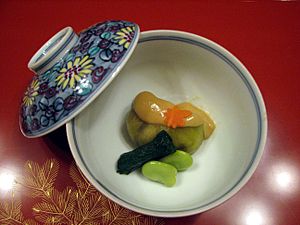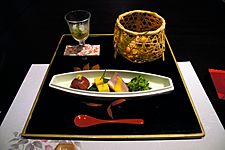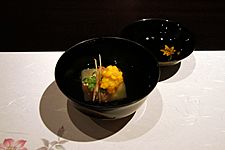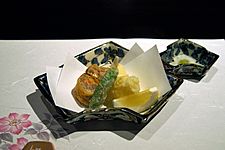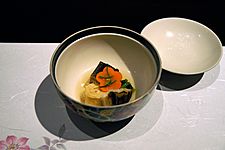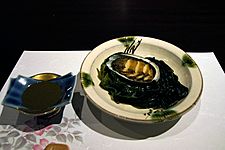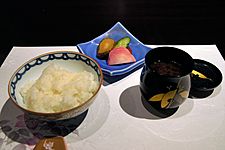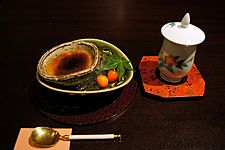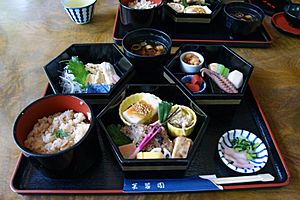Kaiseki facts for kids
Kaiseki (pronounced KAI-seh-kee) is a special type of traditional Japanese dinner. It has many courses, meaning many different dishes served one after another. The word Kaiseki also describes the amazing cooking skills used to make these meals. It's a bit like "haute cuisine" in Western cooking, which means very fancy and high-quality food.
There are two main kinds of traditional Japanese meals called Kaiseki.
- One type, written as "会席", is a set menu of special food. Each person gets their own tray with different dishes. This is often for a gathering or party.
- The second type, written as "懐石", is a simpler meal. It's served by the host of a Japanese tea ceremony (called chanoyu) to guests before they drink the ceremonial tea. This one is also known as cha-kaiseki.
Some people think that modern "new cuisine" styles were inspired by the ideas behind Kaiseki.
Contents
What Does "Kaiseki" Mean?
The Japanese characters (kanji) for "kaiseki" (懐石) literally mean "breast-pocket stone." This name comes from a cool story!
Around the 1500s, a famous tea master named Sen no Rikyū started using these characters. He wanted to show that the meal served during a tea ceremony was simple and humble. The idea came from Zen monks. These monks would put warm stones in their robes, near their stomachs. This helped them feel less hungry during long periods of meditation. So, "breast-pocket stone" meant a small, warm meal to keep hunger away.
Before this, the word Kaiseki (会席料理) just meant "food for a gathering." Today, both sets of characters are still used. To tell them apart, the tea ceremony meal is often called "tea Kaiseki" or cha-kaiseki.
History of Kaiseki Cooking
Modern Kaiseki cooking combines ideas from several old Japanese cooking styles. These styles developed over many centuries:
- Imperial Court Cuisine: This fancy food was made for the emperor and nobles starting in the 800s.
- Buddhist Temple Cuisine: This vegetarian food came from temples in the 1100s. It focuses on healthy and simple ingredients.
- Samurai Warrior Cuisine: This food was for warrior families from the 1300s. It was often hearty and well-prepared.
- Tea Ceremony Cuisine: This simple meal, cha-kaiseki, started in the 1400s. It was designed to be light before drinking tea.
All these styles have influenced Kaiseki. Some chefs make Kaiseki more ornate, like court and samurai food. Others keep it simpler, like temple and tea ceremony meals.
The Art of Kaiseki
Today, Kaiseki is seen as an art form. It's all about balancing the taste, texture, look, and colors of the food. Chefs use only fresh ingredients that are in season. They prepare them in ways that make their natural flavors shine. Often, they use ingredients from the local area too.
The finished dishes are presented beautifully. The plates are chosen to match the food and the season. Dishes are arranged carefully and decorated. Sometimes they use real leaves and flowers. Other times, they use edible decorations that look like plants or animals.
What's in a Kaiseki Meal?
Originally, Kaiseki was just a bowl of miso soup and three side dishes. Now, that's a common Japanese meal style called a "set." Kaiseki has grown to include many more courses. The chef decides what to serve, but here are some common dishes:
- Sakizuke: This is a small appetizer, like a starter.
- Hassun: This course sets the theme for the season. It usually has one type of sushi and a few small side dishes.
- Mukōzuke: This is a dish of sliced seasonal sashimi (raw fish).
- Takiawase: This dish has vegetables served with meat, fish, or tofu. The ingredients are cooked separately.
- Futamono: This is a "lidded dish," usually a soup.
- Yakimono: This is grilled food, often fish.
- Su-zakana: A small dish, like vegetables in vinegar, to clean your palate.
- Suimono: A clear soup with just a few things in it.
- Hiyashi-bachi: Served only in summer, these are chilled, lightly cooked vegetables.
- Naka-choko: Another palate-cleanser, maybe a light, sour soup.
- Shiizakana: A more filling dish, like a hot pot.
- Gohan: A rice dish made with seasonal ingredients.
- Kō no mono: Seasonal pickled vegetables.
- Tome-wan: A miso or vegetable soup served with the rice.
- Mizumono: A seasonal dessert. This could be fruit, a sweet treat, ice cream, or cake.
Cha-kaiseki: The Tea Ceremony Meal
This is the special meal served during a Japanese tea ceremony (chanoyu). It happens before the main tea is served. The basic cha-kaiseki meal usually has "one soup, three side dishes," plus rice. It also includes:
- Suimono: A clear soup served in a small lidded bowl. It helps clean your palate before you share sake (rice wine) with the host.
- Hassun: A tray with small bites from both the mountains and the sea. Guests serve themselves, and it goes with the sake.
- Yutō: A pitcher of hot water with a little browned rice in it. Guests serve themselves this too.
- Kō no mono: Pickles that go with the yutō.
The "one soup, three side dishes" usually means:
- Mukōzuke: Food placed on the far side of each guest's meal tray. It might be sashimi.
- Nimono: Simmered foods, served in individual lidded bowls.
- Yakimono: Grilled foods, often fish, brought out for guests to serve themselves.
Sometimes, extra dishes called shiizakana are added. These go with more rounds of sake.
Casual Kaiseki
Even casual Kaiseki meals are artistic. They arrange ingredients beautifully. They might mix rough pottery with fine patterned bowls to create a cool effect. The bento box is a popular and casual way to enjoy Kaiseki ideas.
Where to Find Kaiseki
You can often find Kaiseki served in traditional Japanese inns called ryokan. It's also served in special small restaurants called ryōtei.
The city of Kyoto is very famous for its Kaiseki. This is because Kyoto was the home of the emperor and nobles for over a thousand years. In Kyoto, Kaiseki-style cooking is sometimes called Kyoto cooking (kyō-ryōri). This name highlights its deep roots in Kyoto's traditions. It even includes some ideas from traditional Kyoto home cooking, like obanzai (everyday side dishes).
How Much Does Kaiseki Cost?
Kaiseki can be quite expensive. Dinners at top traditional restaurants can cost a lot per person, not including drinks. However, there are cheaper options. Lunch menus are usually less expensive. Also, bento boxes offer a more affordable way to try Kaiseki flavors. Sometimes, sitting at a counter is cheaper than having a private room.
At ryokan (inns), the Kaiseki meals might be part of the room price. Some ryokan are now mainly restaurants, so you don't have to stay there to eat. Some traditional menus offer three price levels, often named after pine, bamboo, and plum. Pine is the most expensive, and plum is the least.
See also
 In Spanish: Kaiseki para niños
In Spanish: Kaiseki para niños



